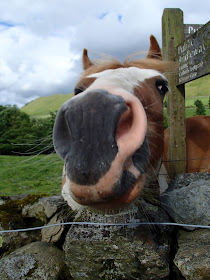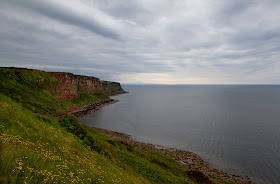 |
| Pavey Ark from Stickle Tarn - Jack's Rake is the diagonal line running up the front. |
Tragic though these events are I'm afraid I'm wholly against the idea of warning signs being placed on dangerous fells for two main reasons; first of all the Lake District is a National Park and should not be cluttered up with unnecessary signage and secondly, even if there were signs I'm pretty sure people would ignore them anyway, or see it as an even greater "badge of honour" to flout the warnings. People ignore signs every single day; "Smoking Kills", "Keep off the Grass", "No Parking" and "30MPH" to name but a few. Signs like these are perceived as being for "other people" and not for whomever is reading them who will, no doubt, justify their reasons for ignoring them in some way or another.
 |
| Striding Edge |
I also think it's very important to keep things in perspective. The second fell I ever climbed was Helvellyn and we went up via Striding Edge, another notorious route where there have been many deaths; we were pretty inexperienced but were aware of the dangers so waited for good weather and took things very steady, along with the several hundred other people on the route the same day. Recently I was speaking with a neighbour who told me that, during one ascent of Striding Edge, his party sat and ate lunch near the final approach and counted over 1000 people going past in the space of an hour. So let's do the maths; lets say that was an average figure for the peak ascent times of roughly 11am - 2pm, so that's 3000 people per day, now let's say there were 5 good climbing days that week, that makes 15,000 for the week and roughly 60,000 for the month. Even if that only happened for 4 months of the year we're already getting on for nearly 1/4 million people. (No wonder Fix the Fells are so busy!). Tragic though it is, statistically speaking, with those kinds of numbers there will be casualties.
 |
| Sharp Edge; another notorious route. |
Many moons ago my job called for me to work with TRL (Transport Research Laboratory) , these guys know all there is to know about road traffic accident and investigation and they told me that the thing they'd found which was most likely to encourage someone to reduce their speed was not a warning sign but a roadside memorial; a sharp reminder of our own mortality. I know on our ascent of Striding Edge the memorials certainly reminded us to stay focused. TRL were passionate about the need for appropriate signage and fully understood the problems caused by too many signs, or unclear or confusing instructions.
Warning signs appear to do very little to warn people. Currently every car park and access point to Morecambe Bay has large warning signs regarding the dangerous sands and fast tides, and yet over one weekend in May 33 people required rescuing. On the other side of the country, anyone who's ever visited Lindisfarne will know that every single shop, car park and tourist attraction carries warnings about the causeway and every year people ignore them and get caught out.
Following any tragic event everyone involved will look back and think how things could have been done differently, or how the same thing could be prevented from happening in the future, and it's important that we learn lessons where we can. But the sad fact is that life is tragic. Millions of people visit the fells each year and sadly some of them get injured and a few will die. If you stick to the safe routes you're likely to remain safe, if you tackle a more dangerous route the risk factor rises. I'm not suggesting that the people involved in these tragedies did anything reckless or foolish, I just honestly don't think that warning signs are the answer.

































